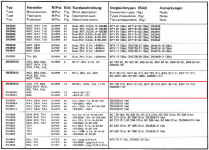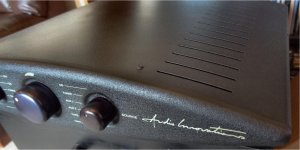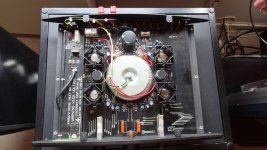Hi I recently replaced a blown channel TR's on my Audio Innovations ALTO mk1 amp, the originals were ST 2n3055, I replaced the blown pair with CDIL 2n3055 which I don't think sound very nice compared to the ST2n3055. I did re-bias them as per the circuit diagram. Does this mean I have poor quality or fake transistors. I think the amp sounds really nice and would like to keep it, so (No jokes about the old design please)
I have also replaced the the output DC blocking caps and power cap.
I would like to replace all of the output transistors with better devices or at least keep them all the same like the ST brand. (Does anyone know where I could get some from in the in the UK) I have limited electronics knowledge unlike some of you fine chaps.
I would be grateful for any advice.
I have also replaced the the output DC blocking caps and power cap.
I would like to replace all of the output transistors with better devices or at least keep them all the same like the ST brand. (Does anyone know where I could get some from in the in the UK) I have limited electronics knowledge unlike some of you fine chaps.
I would be grateful for any advice.
The problem with the 2N3055 is that it is such an old device (historically) that you find the offerings available today are somewhat different spec wise. The ST device (according to the ST data sheet) has for example an Ft of over 3Mhz (on a par with modern devices) whereas I think of the original 2N3055 as struggling to reach 600khz.
The CDIL spec shows an hfe of 5 (minimum) which strikes me as appaling tbh
I'm thinking something like the OnSemi MJ21194G might be a suitable replacement.
MJ21194G - ON SEMICONDUCTOR - TRANSISTOR, NPN, TO-3 | CPC From This Range
The CDIL spec shows an hfe of 5 (minimum) which strikes me as appaling tbh
I'm thinking something like the OnSemi MJ21194G might be a suitable replacement.
MJ21194G - ON SEMICONDUCTOR - TRANSISTOR, NPN, TO-3 | CPC From This Range
Thanks Mooly, So it looks like those CDIL trannys are pretty crap then, no wonder the right channel sounds terrible compared with the left (ST) I thought I had wax in my ear until I started mono comparisons with both ears.
So the ft is important like the hfe for good sound?
Do you think I would be better off changing all of them for the MJ21194G or just try and get some more ST's, I don't really want to chance blowing something if the values are to far out.
Before the right ch blew (Thanks to a mate who borrowed it) the sound has been pretty impressive for a cheap amp, the sound staging in amazing, I've never heard another amp like this that almost hypnotizes me with the sound.
Thanks for the other suggestions but I see the BD73 also has low ft and I keep reading this is bad for audio, can someone explain?
So the ft is important like the hfe for good sound?
Do you think I would be better off changing all of them for the MJ21194G or just try and get some more ST's, I don't really want to chance blowing something if the values are to far out.
Before the right ch blew (Thanks to a mate who borrowed it) the sound has been pretty impressive for a cheap amp, the sound staging in amazing, I've never heard another amp like this that almost hypnotizes me with the sound.
Thanks for the other suggestions but I see the BD73 also has low ft and I keep reading this is bad for audio, can someone explain?
Attachments
Last edited:
You will find some useful discussions on substituting 2N3055 in the Quad forums. I believe the Quad 303 used what were essentially 2N3055 equivalents, but individually selected for a wider SOA. The contributors to those forums have done a lot of thinking about and testing of substitutes.
They do give a caution though - watch out for stability issues. The original 2N3055s had a pretty limited frequency response (as you mention), which contributed to the 303's "bombproof" reputation. There is a risk that substituting higher fT types will turn a stable amplifier into an unstable one - either ruining sound quality or even causing OP stage to self-destruct. Those Quad forums are well worth looking at.
They do give a caution though - watch out for stability issues. The original 2N3055s had a pretty limited frequency response (as you mention), which contributed to the 303's "bombproof" reputation. There is a risk that substituting higher fT types will turn a stable amplifier into an unstable one - either ruining sound quality or even causing OP stage to self-destruct. Those Quad forums are well worth looking at.
Yeah, you may be hearing oscillations. You can't buy real 2n3055, everything is faster. On dynaco ST120 amps, we put ~22 pf between base and emitter of the driver transistors ahead of the output transistors. Faster output transistors should give better sound according to the simulations done by someone on the Leak Delta 70, but oscillations sound bad and consume the transistor doing the wrong thing. I've never heard my ST120 with the original 2n3772 or RCA 5 digit (high Vceo 2n3055), those were burnt up when I bought it, but with NTE60 (probably MJ15003 equivalents) it always sounded okay at decent volume. Not nearly as vile as the reviews in 1966 said it was. It did have a low volume distortion, that is another issue.
To detect oscillation without a scope, if you have an old fashioned VOM with a 2VAC and 20 VAC scales, put a .47 uf (microfarad in newspeak) capacitor in series with the input on VAC and measure the output with the input shorted. Any significant voltage you can't hear, could be RF oscillation. Then change the cap to 470 pf or something. Still have significant AC voltage on the output, for sure it is RF. This test won't work with DVM's, they just produce random numbers when subjected to RF oscillations.
Personally I like the MJ15015G as a sub for the 2n3055, they are about $3 cheaper than MJ15003 and about $2.50 cheaper than MJ21194G. They also have a higher Vceo which is important in my ST120, and they have a specified safe operating area, which hadn't been defined in 1966 IMHO. They are faster than 2n3055, however. Put the little caps in on the drivers, and if you don't have a zobel network on the output (12 turn inductor in series transistor collector junction to speaker hot, 1 k resistor and a cap in series between speaker hot and speaker ground) add one. See the "TIP mod" for the dynaco ST120 on greg dunn's website. This mod is probably a good idea for any original old PWB designed to drive 2n3055 or earlier that wasn't tested for parts faster than that. You can make the inductor by winding any old thin wire around a china marker or fat grade school pencil. Dynaco had you wind them around the output caps, rather quaint.
To detect oscillation without a scope, if you have an old fashioned VOM with a 2VAC and 20 VAC scales, put a .47 uf (microfarad in newspeak) capacitor in series with the input on VAC and measure the output with the input shorted. Any significant voltage you can't hear, could be RF oscillation. Then change the cap to 470 pf or something. Still have significant AC voltage on the output, for sure it is RF. This test won't work with DVM's, they just produce random numbers when subjected to RF oscillations.
Personally I like the MJ15015G as a sub for the 2n3055, they are about $3 cheaper than MJ15003 and about $2.50 cheaper than MJ21194G. They also have a higher Vceo which is important in my ST120, and they have a specified safe operating area, which hadn't been defined in 1966 IMHO. They are faster than 2n3055, however. Put the little caps in on the drivers, and if you don't have a zobel network on the output (12 turn inductor in series transistor collector junction to speaker hot, 1 k resistor and a cap in series between speaker hot and speaker ground) add one. See the "TIP mod" for the dynaco ST120 on greg dunn's website. This mod is probably a good idea for any original old PWB designed to drive 2n3055 or earlier that wasn't tested for parts faster than that. You can make the inductor by winding any old thin wire around a china marker or fat grade school pencil. Dynaco had you wind them around the output caps, rather quaint.
Last edited:
I Replaced the 3 main caps which were identical in spec and brand to the originals so I dont think that is the problem Telstar. I hear what everyone is saying about using faster transistors and that's what I'm worried about. How will I know if it's oscillating? will I hear something? or will the output pair just get very hot quickly. If I do try the MJ15003 from On Semi do I need to set bias very low at first just in case. The last thing I want to do is fry the amp. And from what other are saying here I may need to put a small value cap across the base and emitter of the driver if I do get problems. Is there anything else I need to consider when changing them?
I converted an old Maplin 225WRMS amp with 2n3055 and MJ2955 to a newer design.
I used MG6330 instead of 2n3055.
Its a different package but will bolt to a heatsink OK.
You will need to check for oscillation as these are faster transistors.
You might need to tweak the VAS miller capacitor.
I used MG6330 instead of 2n3055.
Its a different package but will bolt to a heatsink OK.
You will need to check for oscillation as these are faster transistors.
You might need to tweak the VAS miller capacitor.
Farnell.com sells real ON semi parts here in the US. I've bought some from mouser.com, also. Both have European warehouses, if you sign on you will be asked for your country. I don't buy anything from E-bay. Those user ratings are rediculous. Ratings from the ignorant. If you don't do a Vceo check on your parts and an soa check, you have no idea if they are real or not if not buying from an authorized distributor
You need to use a scope or do the VOM check I detailed above to check for oscillation. You may be able to use the "2n3055" you have, if it is oscillating and you get rid of it. They are patently something faster, the factory that made those old slow parts in Indianapolis has been demolished and replaced by a shopping mall, I believe. Your problem may be your boards are laid out for slow parts, and they don't make those anymore, anywhere.
If you can't buy a scope and probes or VOM, buy a 50 microamp meter and make a 2 VAC meter. They still sell actual analog panel meters. I don't recommend a used scope. I bought one last year and it lasted two sessions before the electrolytic caps (probably) froze the sweep. And the board are glued in, I haven't even figured out how to get the boards out to work on them. Waste of $40. Anything you can afford will be that old. At least VOM's dont have e-caps in them. My VOM is a Simpson 266 200kohm/volt.
You need to use a scope or do the VOM check I detailed above to check for oscillation. You may be able to use the "2n3055" you have, if it is oscillating and you get rid of it. They are patently something faster, the factory that made those old slow parts in Indianapolis has been demolished and replaced by a shopping mall, I believe. Your problem may be your boards are laid out for slow parts, and they don't make those anymore, anywhere.
If you can't buy a scope and probes or VOM, buy a 50 microamp meter and make a 2 VAC meter. They still sell actual analog panel meters. I don't recommend a used scope. I bought one last year and it lasted two sessions before the electrolytic caps (probably) froze the sweep. And the board are glued in, I haven't even figured out how to get the boards out to work on them. Waste of $40. Anything you can afford will be that old. At least VOM's dont have e-caps in them. My VOM is a Simpson 266 200kohm/volt.
Last edited:
Surely, there are agents in the UK for On-Semi. Just about every major, reputable industry distributor around the world sells their product. If you can't rely on CPC, Farnell, RS, Cricklewood etc, then ask Management for assurances or to see the bona fides before passing over any cash. You can even even buy direct from some manufacturers like Fairchild and On-Semi or for small quantities, a few free samples are possible in their educational/developer assistance programs.
Yes, you may pay more with the big margin distributors but rather than grow ulcers worrying about Ebay "bargains" you could have genuine parts fitted and enjoy the music before the fakes even leave Hongkong.
Yes, you may pay more with the big margin distributors but rather than grow ulcers worrying about Ebay "bargains" you could have genuine parts fitted and enjoy the music before the fakes even leave Hongkong.
Thanks Mooly, So it looks like those CDIL trannys are pretty crap then, no wonder the right channel sounds terrible compared with the left (ST) I thought I had wax in my ear until I started mono comparisons with both ears.
So the ft is important like the hfe for good sound?
Do you think I would be better off changing all of them for the MJ21194G or just try and get some more ST's, I don't really want to chance blowing something if the values are to far out.
Before the right ch blew (Thanks to a mate who borrowed it) the sound has been pretty impressive for a cheap amp, the sound staging in amazing, I've never heard another amp like this that almost hypnotizes me with the sound.
Thanks for the other suggestions but I see the BD73 also has low ft and I keep reading this is bad for audio, can someone explain?
Lets just add to all this that if the amp is really distorted on the repaired channel i.e. you can hear obvious distortion at normal levels, then I think you have to look a bit further into this if only to confirm that there are no other issues such as collateral damage to the driver stages or any resistors that have suffered when the original failure occured. If its more a case of "I don't think its quite as good as it was" then fair enough.
The CDIL's are perhaps truer to an original 2N3055 of 40 years ago rather then the modern ST devices the amp used (which are not)
"Personally I like the MJ15015G as a sub for the 2n3055,"
I would agree, I buy them and the MJ15016 complement in quantity.
$1.47 each, quantity of one!
MJ15015G | Arrow Electronics Components Search
I would agree, I buy them and the MJ15016 complement in quantity.
$1.47 each, quantity of one!
MJ15015G | Arrow Electronics Components Search
.
I would be grateful for any advice.
I replaced alot of blown 2N3055"s with 2N3773's in my repair days a long time ago and never seen any of those amps on my bench ever again !
What I did get back was positive feedback from my customers who loved the "new" sound of their repaired amps .
Cheers ,
Rens
Also you can try the 2N3442G.
The 3442 is probably closer to the original sub-1-MHz 3055 than anything else available today. I'm surprised it is still around, actually.
- Status
- This old topic is closed. If you want to reopen this topic, contact a moderator using the "Report Post" button.
- Home
- Amplifiers
- Solid State
- Best 2N3055 alternatives


